fuel CITROEN C4 2007 Owners Manual
[x] Cancel search | Manufacturer: CITROEN, Model Year: 2007, Model line: C4, Model: CITROEN C4 2007Pages: 279, PDF Size: 12.3 MB
Page 2 of 279
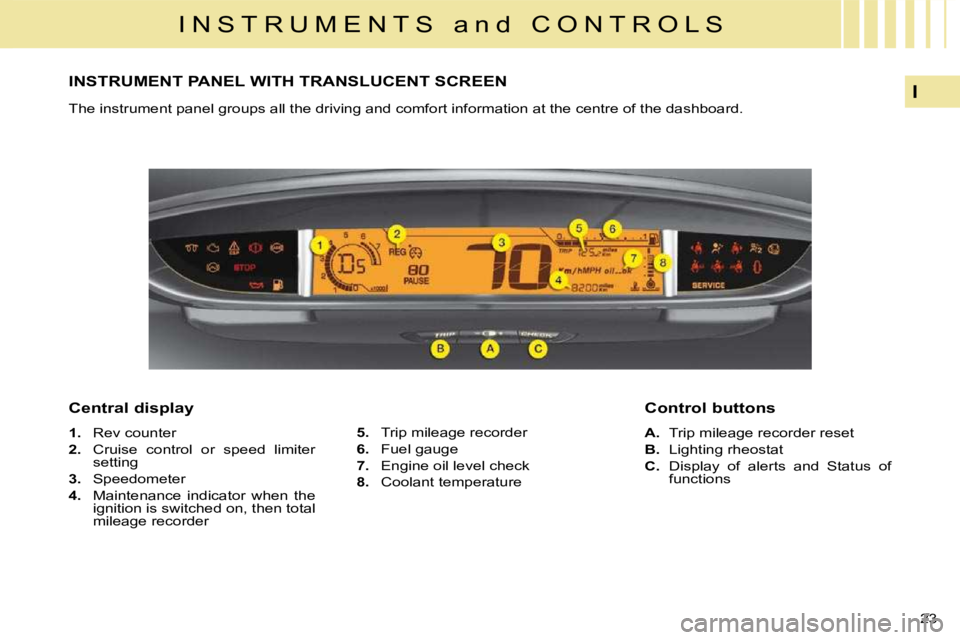
23
I
I N S T R U M E N T S a n d C O N T R O L S
INSTRUMENT PANEL WITH TRANSLUCENT SCREEN
The instrument panel groups all the driving and comfort information at the centre of the dashboard.
Central display
1. Rev counter
2. Cruise control or speed limiter
setting
3. Speedometer
4. Maintenance indicator when the
ignition is switched on, then total
mileage recorder
5. Trip mileage recorder
6. Fuel gauge
7. Engine oil level check
8. Coolant temperature Control buttons
A. Trip mileage recorder reset
B. Lighting rheostat
C. Display of alerts and Status of
functions
Page 5 of 279
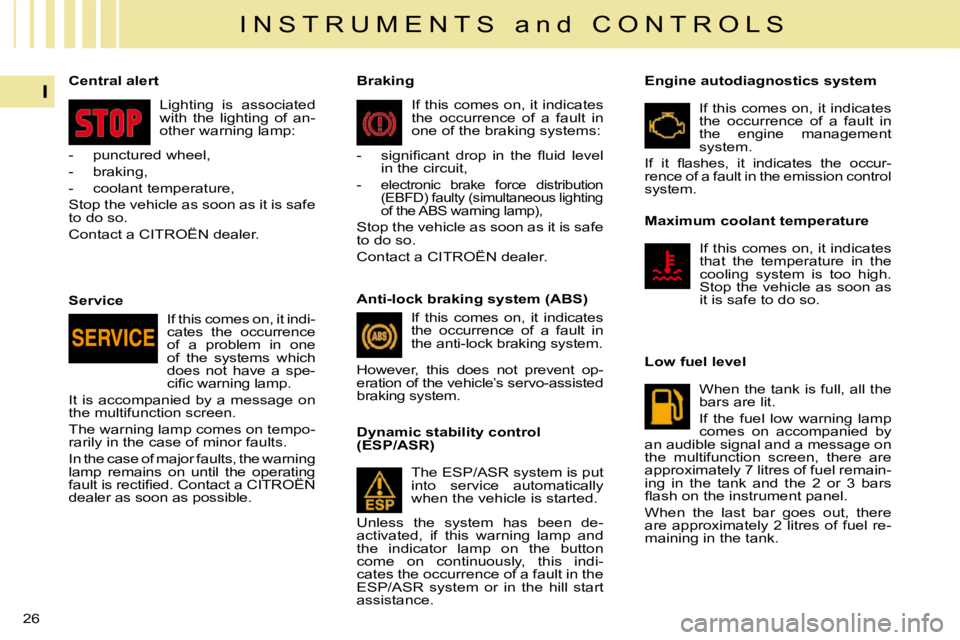
26
I
I N S T R U M E N T S a n d C O N T R O L S Maximum coolant temperature If this comes on, it indicates
that the temperature in the
cooling system is too high.
Stop the vehicle as soon as
it is safe to do so.
Low fuel level When the tank is full, all the
bars are lit.
If the fuel low warning lamp
comes on accompanied by
an audible signal and a message on
the multifunction screen, there are
approximately 7 litres of fuel remain-
ing in the tank and the 2 or 3 bars
�fl� �a�s�h� �o�n� �t�h�e� �i�n�s�t�r�u�m�e�n�t� �p�a�n�e�l�.�
When the last bar goes out, there
are approximately 2 litres of fuel re-
maining in the tank.
Lighting is associated
with the lighting of an-
other warning lamp:
Service If this comes on, it indi-
cates the occurrence
of a problem in one
of the systems which
does not have a spe-
�c�i�fi� �c� �w�a�r�n�i�n�g� �l�a�m�p�.�
It is accompanied by a message on
the multifunction screen.
The warning lamp comes on tempo-
rarily in the case of minor faults.
In the case of major faults, the warning
lamp remains on until the operating
�f�a�u�l�t� �i�s� �r�e�c�t�i�fi� �e�d�.� �C�o�n�t�a�c�t� �a� �C�I�T�R�O��N�
dealer as soon as possible. Braking
If this comes on, it indicates
the occurrence of a fault in
one of the braking systems:
� � � �-� � �s�i�g�n�i�fi� �c�a�n�t� �d�r�o�p� �i�n� �t�h�e� �fl� �u�i�d� �l�e�v�e�l� in the circuit,
-
electronic brake force distribution
(EBFD) faulty (simultaneous lighting
of the ABS warning lamp),
Stop the vehicle as soon as it is safe
to do so.
Contact a CITROËN dealer.
Dynamic stability control
(ESP/ASR)
The ESP/ASR system is put
into service automatically
when the vehicle is started.
Unless the system has been de-
activated, if this warning lamp and
the indicator lamp on the button
come on continuously, this indi-
cates the occurrence of a fault in the
ESP/ASR system or in the hill start
assistance. Engine autodiagnostics system
If this comes on, it indicates
the occurrence of a fault in
the engine management
system.
� �I�f� �i�t� �fl� �a�s�h�e�s�,� �i�t� �i�n�d�i�c�a�t�e�s� �t�h�e� �o�c�c�u�r�-
rence of a fault in the emission control
system.
Central alert
- punctured wheel,
- braking,
- coolant temperature,
Stop the vehicle as soon as it is safe
to do so.
Contact a CITROËN dealer.
Anti-lock braking system (ABS) If this comes on, it indicates
the occurrence of a fault in
the anti-lock braking system.
However, this does not prevent op-
eration of the vehicle’s servo-assisted
braking system.
Page 10 of 279
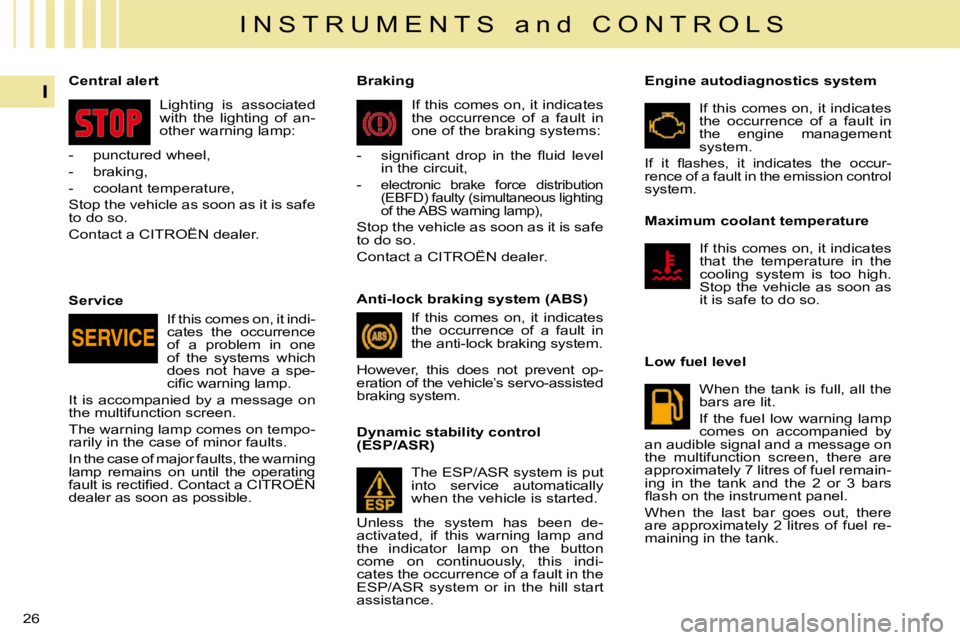
26
I
I N S T R U M E N T S a n d C O N T R O L S Maximum coolant temperature If this comes on, it indicates
that the temperature in the
cooling system is too high.
Stop the vehicle as soon as
it is safe to do so.
Low fuel level When the tank is full, all the
bars are lit.
If the fuel low warning lamp
comes on accompanied by
an audible signal and a message on
the multifunction screen, there are
approximately 7 litres of fuel remain-
ing in the tank and the 2 or 3 bars
�fl� �a�s�h� �o�n� �t�h�e� �i�n�s�t�r�u�m�e�n�t� �p�a�n�e�l�.�
When the last bar goes out, there
are approximately 2 litres of fuel re-
maining in the tank.
Lighting is associated
with the lighting of an-
other warning lamp:
Service If this comes on, it indi-
cates the occurrence
of a problem in one
of the systems which
does not have a spe-
�c�i�fi� �c� �w�a�r�n�i�n�g� �l�a�m�p�.�
It is accompanied by a message on
the multifunction screen.
The warning lamp comes on tempo-
rarily in the case of minor faults.
In the case of major faults, the warning
lamp remains on until the operating
�f�a�u�l�t� �i�s� �r�e�c�t�i�fi� �e�d�.� �C�o�n�t�a�c�t� �a� �C�I�T�R�O��N�
dealer as soon as possible. Braking
If this comes on, it indicates
the occurrence of a fault in
one of the braking systems:
� � � �-� � �s�i�g�n�i�fi� �c�a�n�t� �d�r�o�p� �i�n� �t�h�e� �fl� �u�i�d� �l�e�v�e�l� in the circuit,
-
electronic brake force distribution
(EBFD) faulty (simultaneous lighting
of the ABS warning lamp),
Stop the vehicle as soon as it is safe
to do so.
Contact a CITROËN dealer.
Dynamic stability control
(ESP/ASR)
The ESP/ASR system is put
into service automatically
when the vehicle is started.
Unless the system has been de-
activated, if this warning lamp and
the indicator lamp on the button
come on continuously, this indi-
cates the occurrence of a fault in the
ESP/ASR system or in the hill start
assistance. Engine autodiagnostics system
If this comes on, it indicates
the occurrence of a fault in
the engine management
system.
� �I�f� �i�t� �fl� �a�s�h�e�s�,� �i�t� �i�n�d�i�c�a�t�e�s� �t�h�e� �o�c�c�u�r�-
rence of a fault in the emission control
system.
Central alert
- punctured wheel,
- braking,
- coolant temperature,
Stop the vehicle as soon as it is safe
to do so.
Contact a CITROËN dealer.
Anti-lock braking system (ABS) If this comes on, it indicates
the occurrence of a fault in
the anti-lock braking system.
However, this does not prevent op-
eration of the vehicle’s servo-assisted
braking system.
Page 29 of 279

42
III
C O M F O R T
Air conditioning
To ensure that your system operates
correctly, it is recommended to have
it checked regularly.
Water arising from condensation
in the air conditioning drains away
through a hole provided for this pur-
pose. A pool of water may thus form
under the vehicle when stationary.
To keep the air conditioning com-
pressor well sealed, it is essential to
operate the air conditioning at least
once in every month.
Regardless of the season, the air
conditioning is useful, since it re-
moves humidity and condensation.
To be effective, the air conditioning
should only be used with the windows
closed.
If after a lengthy stop in bright sunlight
the interior temperature is excessive,
ventilate the passenger compartment
by opening the windows for a few
moments, then close them again.
The air conditioning operates by using
power from the engine. This results in
a slight increase in fuel consumption.
Dust filter/Odour filter
(active carbon)
� �T�h�e�r�e� �i�s� �a� �fi� �l�t�e�r� �f�o�r� �e�x�c�l�u�d�i�n�g� �o�d�o�u�r�s�
and dust.
� �T�h�i�s� �fi� �l�t�e�r� �h�a�s� �t�o� �b�e� �c�h�a�n�g�e�d� �i�n� �a�c�-
cordance with the vehicle servicing
schedule (see "Maintenance and
Warranty Guide").
Air circulation
Maximum comfort is obtained when
there is a good distribution of air in
the passenger compartment, both in
the front and in the rear.
� �F�o�r� �o�p�t�i�m�u�m� �o�p�e�r�a�t�i�n�g� �e�f�fi� �c�i�e�n�c�y�,�
take care not to obstruct the air out-
lets under the front seats.
Air vents
The face-level air vents have grilles
�a�n�d� �t�h�u�m�b�w�h�e�e�l�s� �t�o� �a�d�j�u�s�t� �t�h�e� �a�i�r� �fl� �o�w�
and direction (up-down, right-left).
The automatic regulation of the air
conditioning, inside the cabin, uses
the sunlight sensor located on the
dashboard behind the instrument
panel.
Be careful not to obstruct it.
Sensor
Page 58 of 279
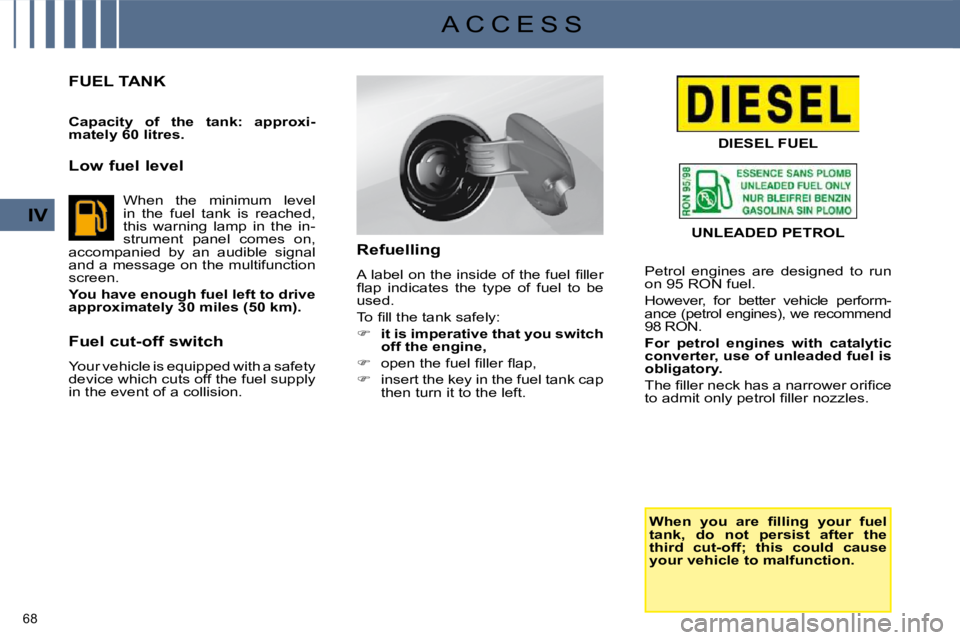
68
IV
A C C E S S
DIESEL FUEL
Refuelling
� �A� �l�a�b�e�l� �o�n� �t�h�e� �i�n�s�i�d�e� �o�f� �t�h�e� �f�u�e�l� �fi� �l�l�e�r�
�fl� �a�p� �i�n�d�i�c�a�t�e�s� �t�h�e� �t�y�p�e� �o�f� �f�u�e�l� �t�o� �b�e�
used.
� �T�o� �fi� �l�l� �t�h�e� �t�a�n�k� �s�a�f�e�l�y�:�
� it is imperative that you switch
off the engine,
� � � �o�p�e�n� �t�h�e� �f�u�e�l� �fi� �l�l�e�r� �fl� �a�p�,�
� insert the key in the fuel tank cap
then turn it to the left. Petrol engines are designed to run
on 95 RON fuel.
However, for better vehicle perform-
ance (petrol engines), we recommend
98 RON.
For petrol engines with catalytic
converter, use of unleaded fuel is
obligatory.
� �T�h�e� �fi� �l�l�e�r� �n�e�c�k� �h�a�s� �a� �n�a�r�r�o�w�e�r� �o�r�i�fi� �c�e�
�t�o� �a�d�m�i�t� �o�n�l�y� �p�e�t�r�o�l� �fi� �l�l�e�r� �n�o�z�z�l�e�s�.�
UNLEADED PETROL
�W�h�e�n� �y�o�u� �a�r�e� �fi� �l�l�i�n�g� �y�o�u�r� �f�u�e�l�
tank, do not persist after the
third cut-off; this could cause
your vehicle to malfunction.
FUEL TANK
Capacity of the tank: approxi-
mately 60 litres.
Low fuel level
When the minimum level
in the fuel tank is reached,
this warning lamp in the in-
strument panel comes on,
accompanied by an audible signal
and a message on the multifunction
screen.
You have enough fuel left to drive
approximately 30 miles (50 km).
Fuel cut-off switch
Your vehicle is equipped with a safety
device which cuts off the fuel supply
in the event of a collision.
Page 59 of 279
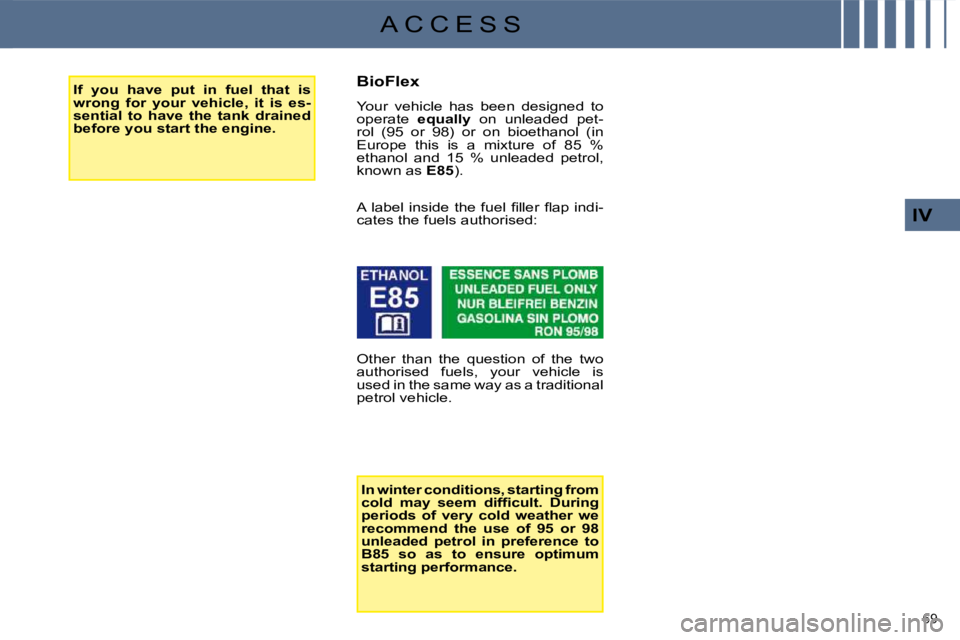
69
IV
A C C E S S
If you have put in fuel that is
wrong for your vehicle, it is es-
sential to have the tank drained
before you start the engine.
� �A� �l�a�b�e�l� �i�n�s�i�d�e� �t�h�e� �f�u�e�l� �fi� �l�l�e�r� �fl� �a�p� �i�n�d�i�-
cates the fuels authorised:
In winter conditions, starting from
�c�o�l�d� �m�a�y� �s�e�e�m� �d�i�f�fi� �c�u�l�t�.� �D�u�r�i�n�g�
periods of very cold weather we
recommend the use of 95 or 98
unleaded petrol in preference to
B85 so as to ensure optimum
starting performance.
BioFlex
Your vehicle has been designed to
operate
equally on unleaded pet-
rol (95 or 98) or on bioethanol (in
Europe this is a mixture of 85 %
ethanol and 15 % unleaded petrol,
known as E85 ).
Other than the question of the two
authorised fuels, your vehicle is
used in the same way as a traditional
petrol vehicle.
Page 115 of 279
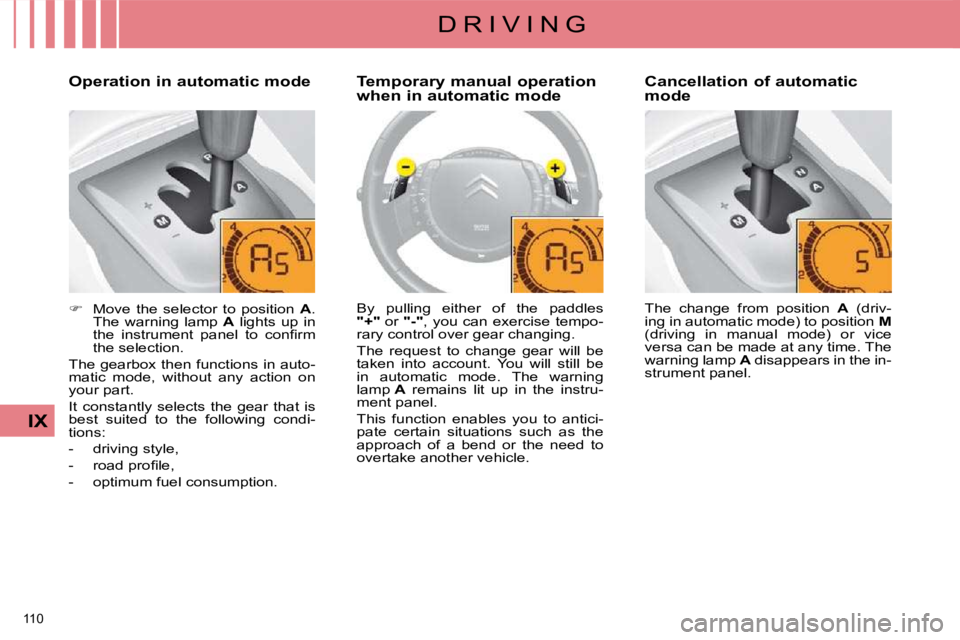
110
IX
D R I V I N G
Temporary manual operation
when in automatic mode
By pulling either of the paddles
" + " or " - ", you can exercise tempo-
rary control over gear changing.
The request to change gear will be
taken into account. You will still be
in automatic mode. The warning
lamp A remains lit up in the instru-
ment panel.
This function enables you to antici-
pate certain situations such as the
approach of a bend or the need to
overtake another vehicle.
� Move the selector to position A .
The warning lamp A lights up in
�t�h�e� �i�n�s�t�r�u�m�e�n�t� �p�a�n�e�l� �t�o� �c�o�n�fi� �r�m�
the selection.
The gearbox then functions in auto-
matic mode, without any action on
your part.
It constantly selects the gear that is
best suited to the following condi-
tions:
- driving style,
� � �-� � �r�o�a�d� �p�r�o�fi� �l�e�,�
- optimum fuel consumption.
Operation in automatic mode
Cancellation of automatic
mode
The change from position A (driv-
ing in automatic mode) to position M
(driving in manual mode) or vice
versa can be made at any time. The
warning lamp A disappears in the in-
strument panel.
Page 129 of 279
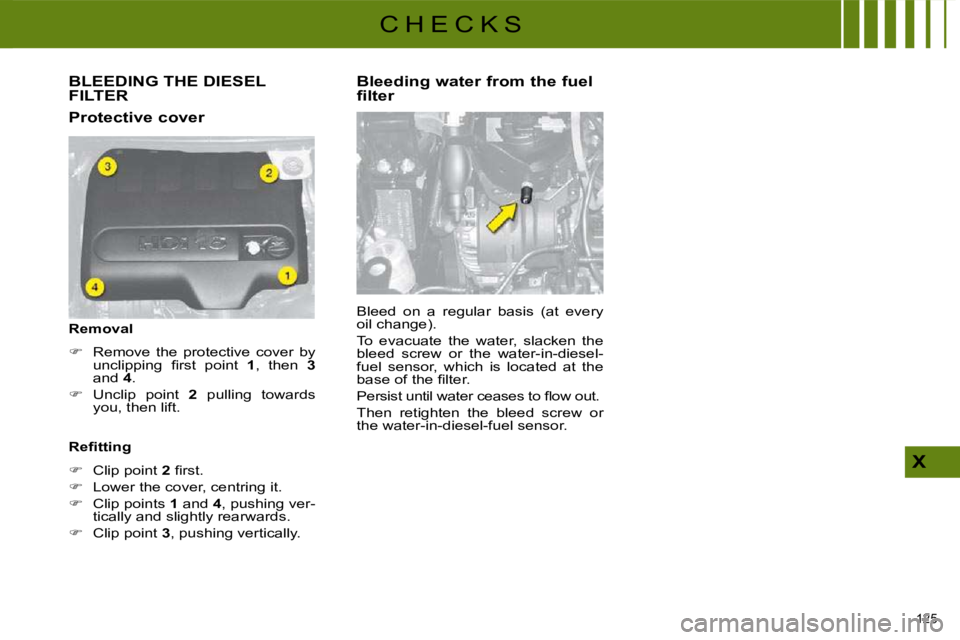
125
X
C H E C K S
BLEEDING THE DIESEL FILTER
Protective cover
Removal
� Remove the protective cover by
�u�n�c�l�i�p�p�i�n�g� �fi� �r�s�t� �p�o�i�n�t� � 1 , then 3
and 4 .
� Unclip point 2 pulling towards
you, then lift.
� � �R�e�fi� �t�t�i�n�g� �
� Clip point 2� � �fi� �r�s�t�.�
� Lower the cover, centring it.
� Clip points 1 and 4 , pushing ver-
tically and slightly rearwards.
� Clip point 3 , pushing vertically. Bleeding water from the fuel
filter
Bleed on a regular basis (at every
oil change).
To evacuate the water, slacken the
bleed screw or the water-in-diesel-
fuel sensor, which is located at the
�b�a�s�e� �o�f� �t�h�e� �fi� �l�t�e�r�.�
� �P�e�r�s�i�s�t� �u�n�t�i�l� �w�a�t�e�r� �c�e�a�s�e�s� �t�o� �fl� �o�w� �o�u�t�.�
Then retighten the bleed screw or
the water-in-diesel-fuel sensor.
Page 130 of 279
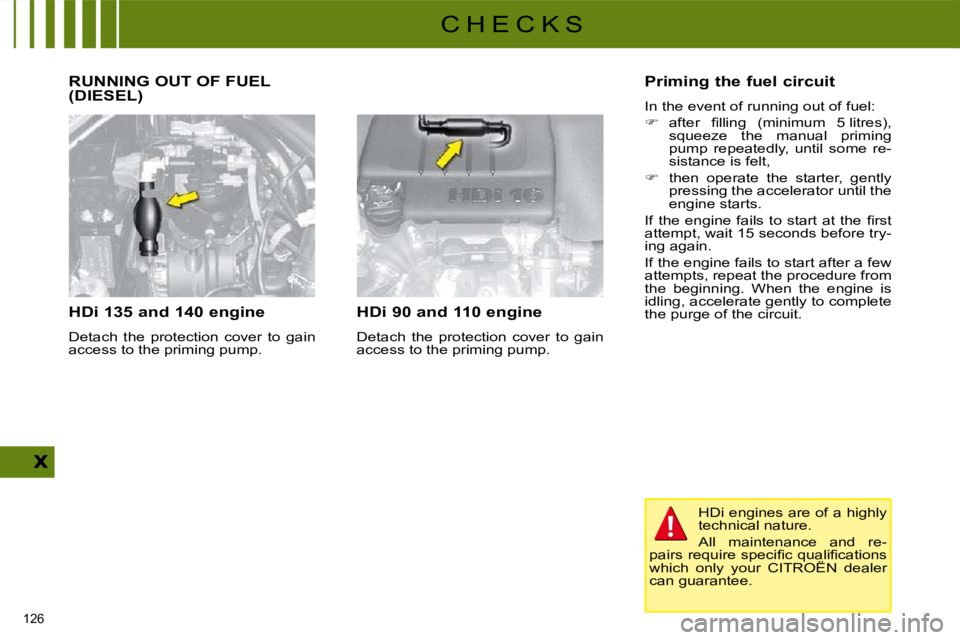
126
C H E C K S
RUNNING OUT OF FUEL (DIESEL)
HDi 135 and 140 engine
Detach the protection cover to gain
access to the priming pump. HDi 90 and 110 engine
Detach the protection cover to gain
access to the priming pump. Priming the fuel circuit
In the event of running out of fuel:
� � � �a�f�t�e�r� �fi� �l�l�i�n�g� �(�m�i�n�i�m�u�m� �5� �l�i�t�r�e�s�)�,�
squeeze the manual priming
pump repeatedly, until some re-
sistance is felt,
� then operate the starter, gently
pressing the accelerator until the
engine starts.
� �I�f� �t�h�e� �e�n�g�i�n�e� �f�a�i�l�s� �t�o� �s�t�a�r�t� �a�t� �t�h�e� �fi� �r�s�t�
attempt, wait 15 seconds before try-
ing again.
If the engine fails to start after a few
attempts, repeat the procedure from
the beginning. When the engine is
idling, accelerate gently to complete
the purge of the circuit.
HDi engines are of a highly
technical nature.
All maintenance and re-
�p�a�i�r�s� �r�e�q�u�i�r�e� �s�p�e�c�i�fi� �c� �q�u�a�l�i�fi� �c�a�t�i�o�n�s�
which only your CITROËN dealer
can guarantee.
Page 132 of 279
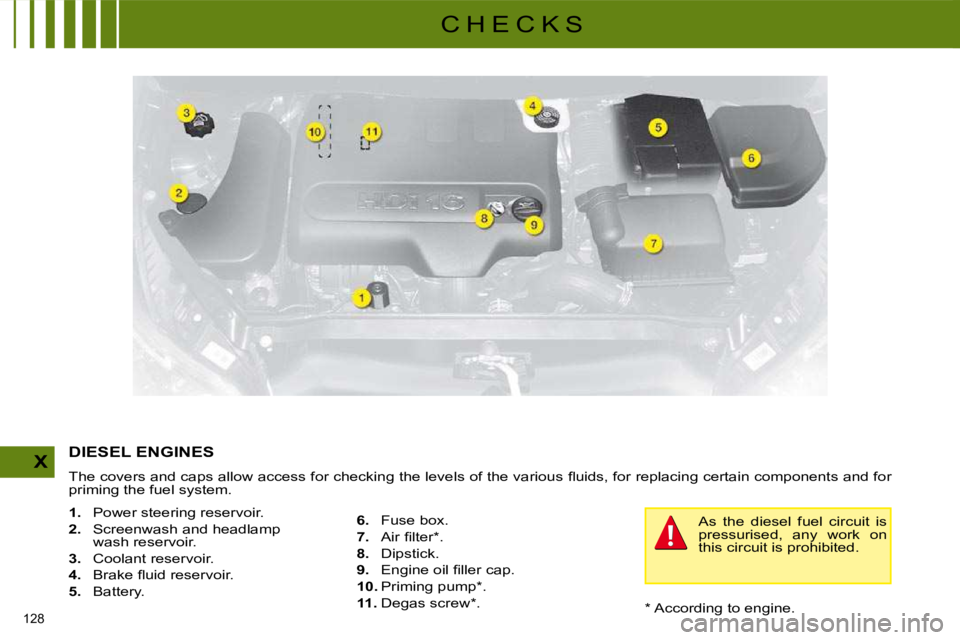
128
X
C H E C K S� � �*� � � �A�c�c�o�r�d�i�n�g� �t�o� �e�n�g�i�n�e�.� �
DIESEL ENGINES
� �T�h�e� �c�o�v�e�r�s� �a�n�d� �c�a�p�s� �a�l�l�o�w� �a�c�c�e�s�s� �f�o�r� �c�h�e�c�k�i�n�g� �t�h�e� �l�e�v�e�l�s� �o�f� �t�h�e� �v�a�r�i �o�u�s� �fl� �u�i�d�s�,� �f�o�r� �r�e�p�l�a�c�i�n�g� �c�e�r�t�a�i�n� �c�o�m�p�o�n�e�n�t�s� �a�n�d� �f�o�r�
priming the fuel system.
1. Power steering reservoir.
2. Screenwash and headlamp
wash reservoir.
3. Coolant reservoir.
4. � � �B�r�a�k�e� �fl� �u�i�d� �r�e�s�e�r�v�o�i�r�.�
5. Battery.
6. Fuse box.
7. � � �A�i�r� �fi� �l�t�e�r� �*� �.�
8. Dipstick.
9. � � �E�n�g�i�n�e� �o�i�l� �fi� �l�l�e�r� �c�a�p�.�
10. � � �P�r�i�m�i�n�g� �p�u�m�p� �*� �.�
11. � � �D�e�g�a�s� �s�c�r�e�w� �*� �.� � As the diesel fuel circuit is
pressurised, any work on
this circuit is prohibited.